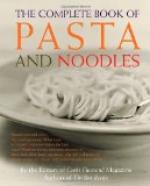* * * * *
The reader cannot fail to remark the close resemblance there is between the first parts of the Arabian and Russian stories; and the second parts of both reappear in many tales of the Silly Son. The goat’s carcase substituted for the dead man occurs, for instance, in the Norse story of Silly Matt; in the Sicilian story of Giufa; in M. Riviere’s Contes Populaires de la Kabylie du Djurdjura; and “Foolish Sachuli,” in Miss Stokes’ Indian Fairy Tales. The incident of the pretended shower of broiled fish and flesh is found in Campbell’s Tales of the West Highlands (porridge and pancakes); in Riviere’s Tales of the Kabail (fritters); “Foolish Sachuli” (sweetmeats); Giufa, the Sicilian Booby (figs and raisins); and in M. Leger’s Contes Populaires Slaves, where, curiously enough, the trick is played by a husband upon his wife. It is perhaps worth while reproducing the Russian story from Leger, in a somewhat abridged form, as follows:
In tilling the ground a labourer found a treasure, and carrying it home, said to his wife, “See! Heaven has sent us a fortune. But where can we conceal it?” She suggested he should bury it under the floor, which he did accordingly. Soon after this the wife went out to fetch water, and the labourer reflected that his wife was a dreadful gossip, and by to-morrow night all the village would know their secret. So he removed the treasure from its hiding-place and buried it in his barn, beneath a heap of corn. When the wife came back from the well, he said to her quite gravely, “To-morrow we shall go to the forest to seek fish; they say there’s plenty there at present.” “What! fish in the forest?” she exclaimed. “Of course,” he rejoined; “and you’ll see them there.” Very early next morning he got up, and took some fish, which he had concealed in a basket. He went to the grocer’s and bought a quantity of sweet cakes. He also caught a hare and killed it. The fish and cakes he disposed of in different parts of the wood, and the hare he hooked on a fishing-line, and then threw it in the river. After breakfast he took his wife with him into the wood, which they had scarcely entered when she found a pike, then a perch, and then a roach, on the ground. With many exclamations of surprise, she gathered up the fish and put them in her basket. Presently they came to a pear-tree, from the branches of which hung sweet cakes. “See!” she cried. “Cakes on a pear-tree!” “Quite natural,” replied he; “it has rained cakes, and some have remained on this tree; travellers have picked up the rest.” Continuing their way to the village, they passed near a stream. “Wait a little,” said the husband; “I set my line early this morning, and I’ll look if anything is caught on it.” He then pulled in the line, and behold, there was a hare hooked on to it! “How extraordinary!” cries the good wife—“a hare in the water!” “Why,” says he, “don’t you know there are hares in the water as well as rats?”




